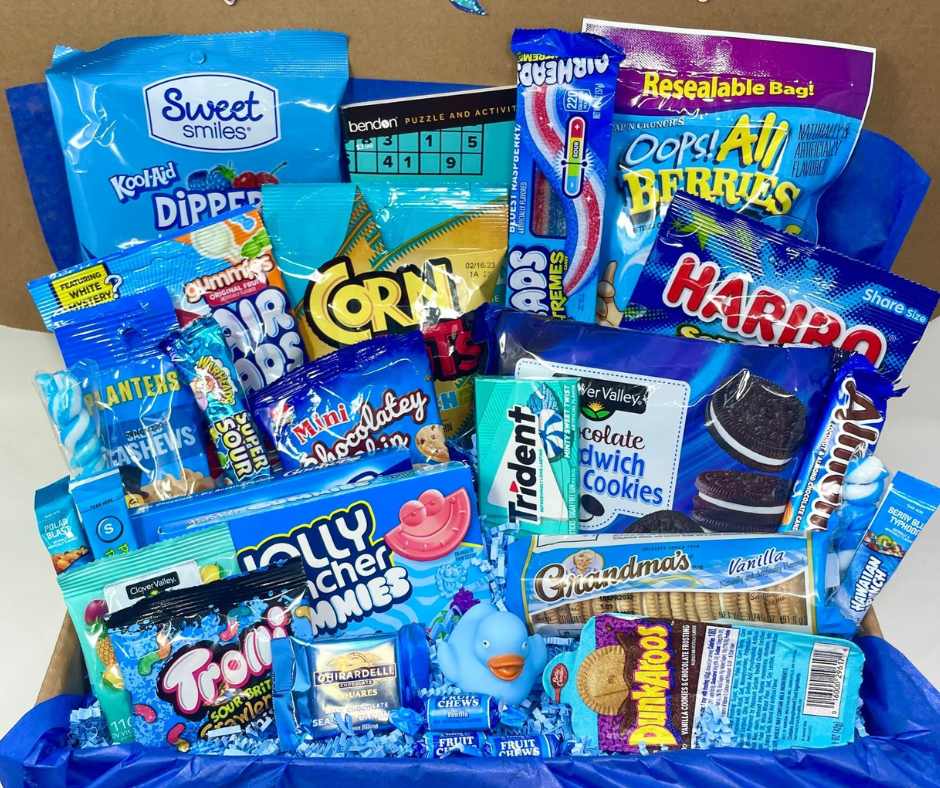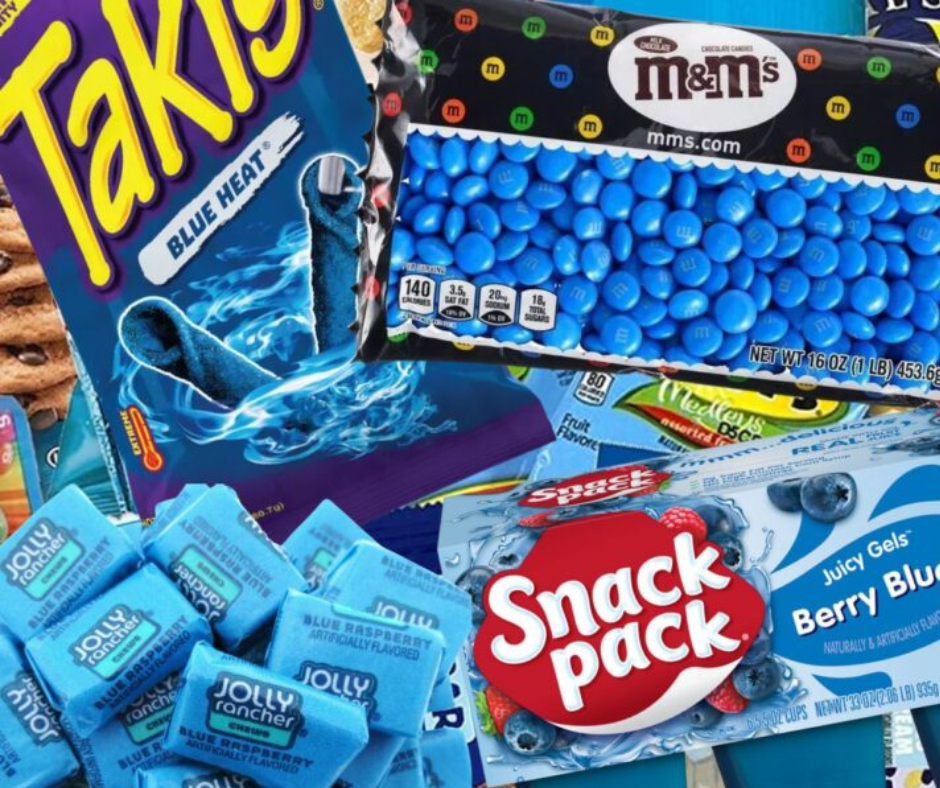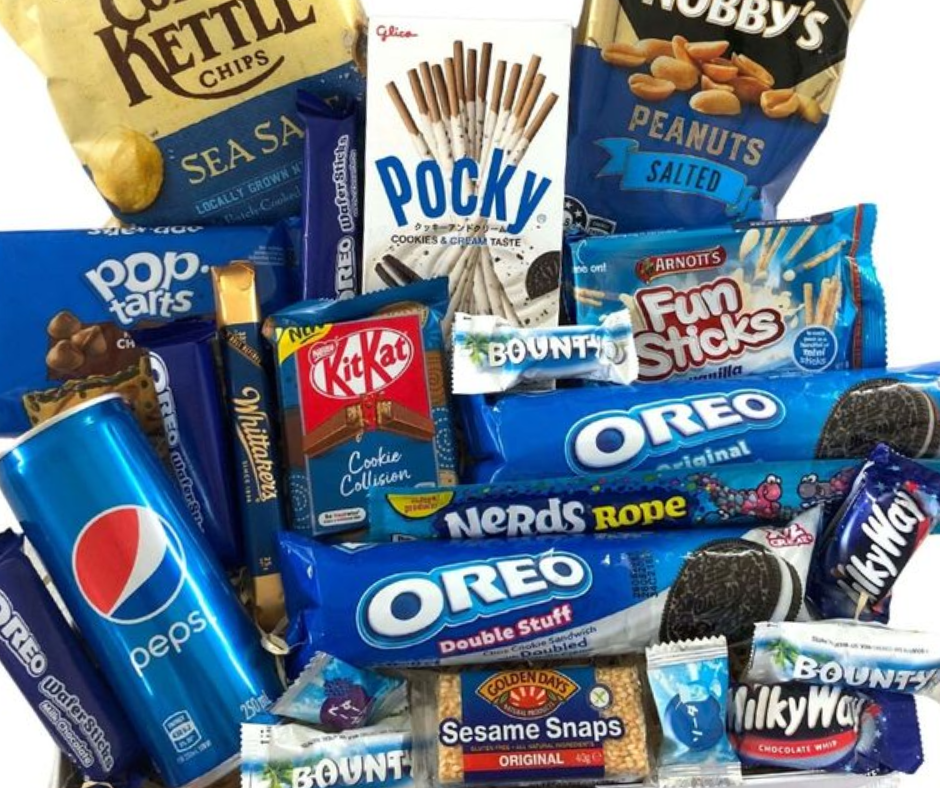Introduction
Blue Foods and Snacks have a unique fascination that captures our attention and curiosity. From vibrant blue candies to blue-colored beverages, these food items stand out on store shelves and leave a lasting impression on consumers. This article will explore the allure of Blue Foods and Snacks and their cultural significance.
The Allure Of Blue Foods and Snacks
Blue-colored foods possess a unique visual appeal that makes them stand out among other colors. Our perception of blue is often associated with calmness, tranquility, and nostalgia. When we come across blue-colored foods, they evoke a sense of excitement and playfulness. It’s no wonder that food companies and confectioners have capitalized on this perception to capture consumer attention.
Furthermore, the allure of blue-colored foods goes beyond visual appeal. They often have interesting and unconventional flavors that pique our curiosity. From blueberry-flavored treats to exotic flavors like butterfly pea flower or blue raspberry, these snacks offer novel taste experiences that consumers find intriguing and enjoyable.
The Cultural Significance Of Blue Foods
Blue Foods and Snacks also hold cultural significance in various parts of the world. In many cultures, the color blue is associated with certain meanings and traditions. For example, in some Asian countries, blue represents prosperity and good luck, making blue-colored foods a popular choice for festive celebrations.
Additionally, blue-colored foods often have connections to folklore and mythology. Stories and legends featuring blue-colored ingredients like blueberries or spirulina have been passed down through generations, adding to the intrigue and allure of these edible creations. In some cases, blue foods are even believed to possess mystical or healing properties.
In recent years, there has also been a rise in the popularity of Blue Foods and Snacks due to their Instagrammable appeal. The visually striking nature of these foods makes them highly shareable on social media platforms, leading to increased exposure and popularity.
The fascination with Blue Foods and Snacks can be attributed to their visual appeal, unique flavors, cultural significance, and social media presence. Whether for nostalgia, culinary exploration, or aesthetic value, blue-colored foods continue to captivate consumers and offer a delightful and memorable experience. So, the next time you come across a blue candy or snack, indulge in the allure and enjoy the magic of these fascinating treats.
Blue Potatoes: A Feast For The Eyes And Taste Buds
The Origin And History Of Blue Potatoes
Blue potatoes’ vibrant color and distinct appearance have become popular among food enthusiasts and culinary aficionados. While potatoes are widely known for their versatility and widespread consumption, the unique appeal of blue potatoes sets them apart.
The origin of blue potatoes can be traced back to the Andean region of South America. Native to Peru and Bolivia, blue potatoes have a rich history that dates back thousands of years. They were cultivated by the ancient Inca civilization and played a significant role in their cuisine.
These potatoes were first introduced to Europe during the Spanish colonization of South America in the 16th century. From there, they gradually gained popularity and became an integral part of European culinary traditions. Today, blue potatoes can be found in various regions worldwide, including North America and Asia.
Nutritional Benefits And Unique Flavors Of Blue Potatoes
Blue potatoes not only stand out for their vibrant color but also for their nutritional value. They are a good source of essential nutrients and offer several health benefits. Blue potatoes are rich in carbohydrates, dietary fiber, and potassium, like their traditional white counterparts. They also contain beneficial antioxidants that are responsible for their unique color.
In terms of flavor, blue potatoes offer a delightful surprise for the taste buds. While their texture is similar to other potatoes, blue potatoes have a slightly nutty and earthy taste that sets them apart. This distinct flavor profile makes them an exciting choice for various dishes.
Furthermore, blue potatoes can be prepared in various ways, including boiling, mashing, baking, or frying. They can be used in salads, soups, hash browns, or even as a colorful side dish. Their vibrant color adds an aesthetically pleasing element to any meal, making them a favorite among chefs and home cooks.
Blue potatoes have also gained attention in the culinary world due to their uniqueness and visual appeal. Many renowned chefs and restaurants have incorporated blue potatoes into their menus to create visually stunning and flavorful dishes. Their presence on social media platforms has further increased their popularity, with food enthusiasts sharing eye-catching images of blue potato creations.
In conclusion, the fascination with blue potatoes can be attributed to their origin, history, nutritional benefits, and unique flavors. Whether it’s the nostalgia for ancient civilizations or the desire for culinary exploration, blue potatoes provide a feast for the eyes and taste buds. So, the next time you come across blue potatoes, don’t hesitate to bring their vibrant color and delightful flavors to your table.
Blue Corn: A Vibrant And Versatile Ingredient
The Cultural Significance Of Blue Corn
Blue corn, with its vibrant hue and rich cultural history, has become a fascinating ingredient in Blue Foods and Snacks. Native to the Americas, especially the Southwestern United States and Mexico, blue corn holds significant cultural significance for various indigenous communities. Considered a sacred crop, blue corn has been a staple in their diets for centuries.
Indigenous cultures view blue corn as more than just a food source. It is deeply connected to their spirituality, representing the Earth’s cycle, fertility, and abundance. For example, the Hopi believe that blue corn has powerful healing properties and incorporate it into their spiritual ceremonies. Similarly, the Navajo people consider blue corn a symbol of life and include it in celebrations and rituals.
Beyond its cultural importance, blue corn offers several health benefits. It is packed with anthocyanins, powerful antioxidants that give it a vibrant blue color. These antioxidants help reduce inflammation, improve cardiovascular health, and support brain function. Blue corn is also a good source of dietary fiber, essential minerals, and complex carbohydrates, making it a nutritious choice.
Delicious Blue Corn-based Snacks And Dishes
Blue corn’s unique color and flavor make it an exciting ingredient for various snacks and dishes. Its versatility allows for sweet and savory creations, indulging the taste buds differently.
One popular blue corn-based snack is blue corn tortilla chips. These crunchy chips are made by grinding dried blue corn kernels into masa, which is then formed into thin rounds and fried until crispy. Blue corn tortilla chips provide a visually appealing element to any snack platter and offer a subtly sweet and nutty flavor that pairs well with salsa, guacamole, or other dips.
Blue corn is also used to make delectable blue cornbread. Taking traditional cornbread to a new level, blue corn adds a vibrant touch to the classic recipe. It has a slightly sweeter and earthier taste, making each bite a delightful experience. Blue cornbread can be enjoyed alone or with chili or soups for a comforting meal.
Blue corn pancakes or waffles are an excellent choice for sweet tooth recipients. The blue color adds an element of fun to breakfast, making it visually appealing and enticing for both kids and adults. Blue corn pancakes are often enjoyed with maple syrup or fresh berries, creating a flavorful and colorful breakfast treat.
Beyond snacks and breakfast dishes, blue corn can be used in many recipes, including blue corn enchiladas, blue corn tamale pie, or even blue corn ice cream. Its distinct flavor and striking appearance allow for endless culinary creations that are sure to impress.
In conclusion, blue corn’s cultural significance and versatility have made it a fascinating ingredient in Blue Foods and Snacks. From its rich cultural history to its numerous health benefits, blue corn offers a unique dining experience. Whether enjoyed in the form of tortilla chips, cornbread, or pancakes, blue corn adds vibrancy and flavor to any dish. So, why not embrace the fascination with Blue Foods and Snacks and explore the delightful world of blue corn?
Other Fascinating Blue Foods And Snacks
The Popularity Of Blueberries And Their Health Benefits
Blueberries are delicious and a popular blue-colored food with numerous health benefits. These small, vibrant berries contain antioxidants, vitamins, and minerals that promote overall well-being. Blueberries are known for their high levels of anthocyanins, responsible for their deep blue color and powerful antioxidant properties. These antioxidants help protect the body against oxidative stress and inflammation, reducing the risk of chronic diseases such as heart disease and cancer.
Blueberries are also a good source of fiber, supporting digestive health and promoting feelings of fullness. Additionally, these berries are low in calories, making them a guilt-free snack option. Whether enjoyed fresh, frozen, or incorporated into smoothies, cereals, or baked goods, blueberries are a tasty and nutritious addition to any diet.
Exploring Unique Blue-colored Snacks In Different Cultures
Various cultures worldwide have embraced blue-colored snacks, adding a touch of uniqueness and excitement to their culinary traditions. For example, in Japan, a popular treat called “Aoi Taiyaki,” a blue-colored fish-shaped pastry filled with sweet red bean paste. This snack satisfies the taste buds and delights the eyes with its playful blue hue.
In India, a traditional savory snack called “Blue Corn Bhel” uses blue corn tortilla chips mixed with chopped vegetables, tamarind chutney, and spices. This vibrant snack offers a pleasing visual appeal and a burst of flavors.
In South America, blue potatoes are a staple ingredient for “Papas a la Huancaina,” a traditional Peruvian dish of boiled potatoes topped with a creamy and spicy cheese sauce. The blue potatoes add a distinctive color and flavor to this beloved dish. These examples highlight the cultural significance and creativity associated with embracing Blue Foods and Snacks in different parts of the world.
In conclusion, the fascination with Blue Foods and Snacks extends beyond blue corn. With their health benefits and unique blue-colored snacks in different cultures, blueberries contribute to exploring culinary delights. Whether it’s the nutritional value of blueberries or the cultural significance of blue-colored snacks, incorporating these fascinating blue foods into our diets can add vibrancy, flavor, and excitement to our culinary experiences. So, don’t hesitate to explore the world of Blue Foods and Snacks and indulge in their intriguing and delicious offerings.
The Science Of Blue Food Coloring
The Role Of Blue Food Coloring In Attracting Visual Attention
Blue has long been associated with calmness, serenity, and reliability. When it comes to food, blue isn’t a color that occurs naturally often; this rarity adds to its charm and intrigue. Studies have shown that the color blue can significantly impact our visual attention. The human eye naturally draws to vibrant and contrasting colors, and blue stands out. By incorporating blue food coloring into snacks and dishes, food manufacturers and cooks can entice and captivate consumers with visually striking and attention-grabbing presentations.
Multisensory Perception And The Impact Of Blue-colored Foods
The way we perceive and experience food goes beyond just taste. It is a multisensory experience that involves our senses of sight, smell, touch, and even sound. The color of food plays a crucial role in creating expectations and influencing our perception of flavor and quality. Research has shown that the color blue can uniquely impact our sensory experience with food. Blue-colored foods are often associated with freshness, cleanliness, and indulgence. This perception can influence our expectations and enhance our enjoyment of the food. For example, a blue-colored dessert may evoke excitement and anticipation, making eating even more pleasurable.
In addition to visual perception, the color blue can impact our taste perception. Studies have suggested that people may perceive foods as sweeter when presented in blue containers or when blue food coloring is added. This phenomenon, known as the “blue-plate effect,” is believed to be due to the contrast between the blue and natural colors of food, which can create an illusion of increased sweetness.
The fascination with Blue Foods and Snacks stems from their unique visual appeal and perception. Blue can attract visual attention, create expectations, and enhance our sensory experience with food. From blueberries with their health benefits to creatively designed blue-colored snacks in different cultures, exploring and embracing the world of blue foods can add vibrancy, flavor, and excitement to our culinary experiences. So, why not indulge in the fascinating world of Blue Foods and Snacks and let your senses be delighted?
Conclusion
The fascination and appeal of Blue Foods and Snacks are undeniable. The unique visual appeal and perception they offer make them stand out in the culinary world. Blue has long been associated with feelings of calmness, serenity, and reliability, making it an intriguing choice for food presentation.
The Fascination And Appeal Of Blue Foods and Snacks
The color blue is relatively rare in the natural world of food, which adds to its charm and intrigue. This rarity makes blue-colored foods visually striking and attention-grabbing. Studies have shown that the human eye naturally draws to vibrant and contrasting colors, and blue stands out. By incorporating blue food coloring into snacks and dishes, food manufacturers and cooks can entice and captivate consumers with visually appealing presentations.
Furthermore, the color blue plays a significant role in creating expectations and influencing our perception of flavor and quality. Blue-colored foods are often associated with freshness, cleanliness, and indulgence. This perception can enhance our enjoyment of the food and evoke excitement and anticipation, making the dining experience even more pleasurable.
Exploring New Culinary Experiences With Blue Foods
The fascination with Blue Foods and Snacks has led to exploring new culinary experiences. Blueberries, with their natural deep blue hue, have gained popularity not only for their health benefits but also for their vibrant color. In different cultures, creatively designed blue-colored snacks have become a trend, adding vibrancy, flavor, and excitement to culinary experiences.
The impact of blue-colored foods extends beyond visual perception. Studies have suggested that blue can influence taste perception, making foods appear sweeter when presented in blue containers or when blue food coloring is added. This phenomenon, known as the “blue-plate effect,” arises from the contrast between food’s blue and natural colors, creating an illusion of increased sweetness.
In conclusion, the fascination with Blue Foods and Snacks stems from their unique visual appeal and perception. Blue can attract visual attention, create expectations, and enhance our sensory experience with food. By embracing the world of Blue Foods and Snacks, we can embark on new culinary adventures that stimulate our senses and bring excitement to our dining table. So, why not indulge in the fascinating world of blue foods and let your senses be delighted?
FAQ: Blue Foods and Snacks: Exploring the Fascination with Blue-Colored Foods and Snacks
Q: What are blue foods?
A: Blue foods refer to food items that are naturally or artificially colored blue.
Q: Why are blue foods fascinating?
A: Blue foods are intriguing due to their rarity in nature and their psychological impact on our perception of taste and appeal.
Q: Are blue foods popular on social media?
A: Blue foods are gaining popularity on platforms like Instagram, where visually vibrant food images are widely shared.
Q: Why were blue and red-colored foods rated less appealing than the original food images?
A: Studies have shown that blue and red food coloring can affect our taste perception and visual appeal, leading to lower ratings.
Q: What was the historical association with bright blue food coloring?
A: Traditionally, bright blue food coloring was associated with artificial additives but has lost favor in recent decades.
Q: Are blue foods commonly found in nature?
A: Blue foods are rare in their natural form, making them all the more intriguing.
Q: Can blue foods be found in grocery stores?
A: While blue foods were once considered unappealing for grocery store shelves, “electric blue” beverages and drinks have gained prominence in recent years.
Q: Do people generally find blue foods unappealing?
A: Many people find blue foods unappealing due to their association with artificial colors and potential mismatches between their visual appearance and expected taste.
Q: Have you personally experienced unappealing blue food?
A: Yes, the author recalls attending a conference dinner where blue soup was served, which left a lasting impression of the unappealing nature of blue foods.



